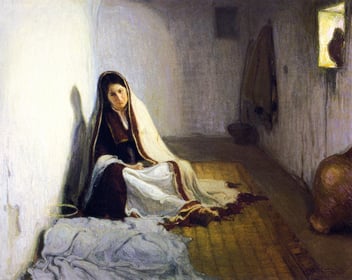A Summary of Christian Teaching in a Christmas Carol
If you grew up in the church as I did, you probably had all the words of your favorite Christmas carols memorized before you even went to school. Maybe, like me, you could sing every verse of every carol without referring to the hymnbook. Does that sound like you?
As proud as you may be of that ability, there’s a problem. Ever heard the adage “familiarity breeds contempt”? Contempt may be too strong a word here, but the fact remains that more than likely you have been singing the carols for years without thinking about the words at all. And that’s a real shame, because some of those old carols are just chock full of good information. In fact, Timothy Keller says of “Hark! the Herald Angels Sing,”[1] “With brilliant economy of style, the carol gives us a summary of the entire Christian teaching.”[2]
In this article we will look at a few of the lines from this familiar carol and remind you of the beautiful biblical truths behind them. Our prayer is that this will prompt you to really think about the carols this year as you sing them and that you will be inspired, like that angelic chorus, to proclaim “Glory to the newborn King!”
[1] Hark! the herald angels sing, “Glory to the newborn King:
peace on earth, and mercy mild, God and sinners reconciled!”
Joyful, all ye nations, rise, join the triumph of the skies;
with th’angelic hosts proclaim, “Christ is born in Bethlehem!”
This Christmas carol opens with the proclamation that God has, through Jesus, reconciled the world to Himself. In fact, that’s why Jesus came. The apostle Paul writes that “God was reconciling the world to himself in Christ, not counting people’s sins against them” (2 Corinthians 5:19). That’s an astonishing gift, even more so because we read in Romans that God did this “while we were God’s enemies” (Romans 5:10)! And He did this by “making peace through his blood, shed on the cross” (Colossians 1:20).
And our proper response to this gracious gift from God is not only to seek reconciliation with one another, but also to “boast in God through our Lord Jesus Christ” (Romans 5:11), much like the angelic host did on that first Christmas morning.
[2] Christ, by highest heaven adored, Christ, the everlasting Lord,
late in time behold him come, offspring of the Virgin’s womb:
veiled in flesh the Godhead see; hail th’incarnate Deity,
pleased with us in flesh to dwell, Jesus, our Immanuel.
The second verse begins with the declaration that Christ is the everlasting Lord. He “was God,” and He was “with God in the beginning” (John 1:1-2). He has been God “from everlasting to everlasting” (Psalm 90:1).
But “when the set time (or, as the King James puts it, the ‘fulness of time’) had fully come, God sent His Son, born of a woman... to redeem those under the law…” (Galatians 4:4-5). This plan was in place “before the creation of the world,” why? So we could be “holy and blameless in His sight” (Ephesians 1:4).
That’s pretty amazing! Think about it. God, your Creator, actually became a man to bring us salvation. “The Word became flesh and made his dwelling among us” (John 1:14) for a short time. John goes on to explain why: “For God so loved the world that he gave his one and only Son, that whoever believes in him shall not perish but have eternal life” (John 3:16).
Matthew explains the beautiful truth behind Jesus’ name: “She will give birth to a son, and you are to give him the name Jesus, because he will save his people from their sins…[and] they will call him Immanuel (which means ‘God with us’)” (Matthew 1:21-23).
Jesus, our Savior and our Immanuel. But wait, there’s more!
[3] Hail the heaven-born Prince of Peace! Hail the Sun of Righteousness!
Light and life to all he brings, risen with healing in his wings.
Mild he lays his glory by, born that we no more may die,
born to raise us from the earth, born to give us second birth.
The third stanza of this carol opens with a few of the other names by which we know our Savior: Prince of peace (Isaiah 9:6), Sun of Righteousness (Malachi 4:2), Light (John 9:5), and Life (John 11:25).
Then, in the second half of that stanza we hear echoes of a beautiful early hymn, found in Philippians 2. Paul speaks here about Jesus:
“Who, being in very nature God, did not consider equality with God something to be used to his own advantage; rather, he made himself nothing by taking the very nature of a servant, being made in human likeness. And being found in appearance as a man, he humbled himself by becoming obedient to death—even death on a cross!
“Therefore God exalted him to the highest place and gave him the name that is above every name, that at the name of Jesus every knee should bow, in heaven and on earth and under the earth, and every tongue acknowledge that Jesus Christ is Lord, to the glory of God the Father.” (Philippians 2:6-11)
Little wonder then that the hymnwriter urges us to join those angels in their proclamation. This year as you sing this carol, remember just why Jesus came. He was “born that we no more may die.” And He achieved that through His death and resurrection. So, celebrate His birth, but rejoice in what His death and resurrection have accomplished for you. Rejoice, and sing, “Glory to the newborn King!”
“Hark! the herald angels sing, ‘Glory to the newborn King!’”
[1] Charles Wesley, “Hark! The Herald Angels Sing” (1739, public domain).
[2] Timothy Keller, Hidden Christmas: The Surprising Truth Behind the Birth of Christ (Penguin Publishing Group. Kindle Edition), p. 3.
.png)




